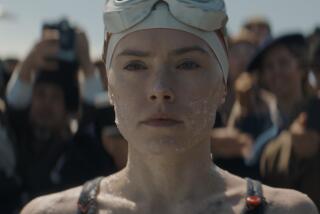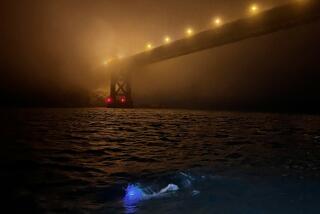Risk Taken on Sailboat Pays Off in a Record Pace for Woman
Last summer Lydia Bird went head over heels into debt to buy a 27-foot sailboat to race alone from Los Angeles to Hawaii.
“I figured I would make it to the other end, where I could sell the boat, or if the boat sank, I would crawl into a life raft and have such a story to tell that I could write a book and make some money to pay for the boat,” says Bird.
Instead, 14 days later, Bird, 34, arrived safely in Hawaii, setting a women’s sailing record along the way.
A sailing instructor at Orange Coast College, Bird hopes that her success will serve as inspiration to other women sailors, and she has designed a special class, exclusively for women, to provide some practical assistance too.
The course, which begins July 10 at the Orange Coast College Sailing Center, 1801 W. Pacific Coast Highway in Newport Beach, will focus on teaching big-boat crewing techniques aboard the college’s 47-foot sloop, Saudade.
“I would like to see more all-women crews out there racing,” says Bird, who is spending the summer with a group of 10 women in Annapolis, Md., preparing for the Whitbread around-the-world race in September. She will return to Orange County to teach her weeklong course, then fly back to Annapolis for more training.
“I really look forward to teaching the class,” she says. “I think women’s sailing has started to accelerate both in terms of women’s events and women becoming involved in sailing, but it is still very much a male-dominated sport. Look at the America’s Cup and there are all male faces. No women to be seen.”
Although Bird’s class is not framed around racing, she believes that ocean racing is a good way to learn all the sailing skills you need.
Bird, originally from Pasadena, says she learned by sailing in local races, including the Newport-to-Ensenada race. When she was 18, she made her first Atlantic passage. And she has participated in the Tour de France a la Voile, a race that covers the entire coastline of France. At the border with Spain, the boats are plucked out of the water, trucked across the Pyrenees and deposited in the Mediterranean.
Before sailing single-handedly from Los Angeles to Hawaii, Bird had hoped to compete in the OSTAR single-handed race from England to Newport, R.I. “But that is hard to do without a sponsor,” she says. “When I realized I wasn’t going to be able to do it, I decided to do the single-handed TransPac race, instead.
“Originally, I wanted to charter a 40-foot boat for the race,” she says. “I put months and months of work toward the race, and then two months before it started, I found I couldn’t get insurance.”
Unable to charter the 40-footer without insurance, Bird opted to buy her own boat so that she could race it uninsured. Since her finances were limited, she had to settle for a much smaller, more affordable 27-foot sailboat.
The passage was rough, with storm winds up to 35 knots and steep seas. “I had four or five knockdowns. The boat literally lay on its side with water coming in the cockpit,” says Bird, who always wore a safety harness to keep her in the boat. “But I had suffered knockdowns before and I realized that it would come back up. I thought I would have felt more vulnerable (in a boat that small), but I had confidence in it. I was never really scared. I think I have spent enough time on the ocean that it wasn’t scary for me.”
Because there was so much wind, Bird had to decide how hard to push the little boat. “It was hard for me to balance the demands of racing with the need to respect the boat and its gear,” says Bird, who kept reminding herself that the boat must be in good condition when the race was over so that she could sell it. “It was hard for me to justify pushing the boat hard and damaging it.”
During the 14-day passage, Bird rarely slept more than an hour at a time. “I would set a kitchen timer for an hour and then get up and look around and check the compass course and the sails. Then I would go back to sleep for another hour,” she says.
Since Bird’s small boat had little in the way of instrumentation, she was forced to rely on celestial navigation. “I ended up going back to the basics,” she says. “I did a lot of my navigation by stars. It was a tremendous feeling to be in this tiny, skittery boat with this sextant in your hand. It was amazing to be in the middle of nowhere--completely alone. But there was so much work to do and the race was so short, I never felt lonely.”
What Bird did feel, she says, was extreme discomfort. “You get real bruised up on a boat that size,” she says. “It’s awkward. You literally have to crawl around on all fours. And the boat leaked. I couldn’t seal the windows and the entire boat was wet the whole time. Everything was soaked with saltwater. It was like working in a steam bath.”
Despite the discomfort, Bird says that, in retrospect, she believes it was better to have a small boat. “There was a lot more wind than they had had in other races,” she says. “So this boat was more manageable for me. It was a good boat for me.”
Out of a fleet of 14 boats, Bird placed fifth overall and broke the women’s record by three days. She sold the boat in Hawaii and returned to California with new sailing goals. This summer she joined the U.S. Women’s Challenge Group in preparing a 57-foot aluminum sloop for the around-the-world Whitbread race.
“Whether we get to make the race depends upon getting corporate funding,” Bird says. “We need to get a $1.5-million corporate sponsor.”
In the meantime, the women, who range in age from 22 to 42, are practicing in the waters off Annapolis. “The crew comes from all over,” Bird says. “The woman who is organizing it is from Rhode Island. A few are from the West Coast, and one woman is from England.”
The all-women crew represents the change that is going on in sailing today, according to Bird. “If you were a woman sailor, people didn’t take you very seriously,” she says. “That was in the past. There are a lot of big changes going on now. Women may have to work a lot harder to get the kind of muscle strength you need, but as new equipment comes out, there are ways to get around that. I tell the women sailors in my class that you have to learn to use your brains more. If you can’t get a line in by sheer beef, you have to get past the old stigmas and stereotypes. You have to set your mind on being able to do it.”
Fishing Derby--A free fishing clinic, followed by a fishing derby with more than $1,000 in prizes, will be held at the San Clemente Pier on July 8 and 9.
The clinic will run from 7 a.m. to noon on July 8 and the derby will follow on July 9 from 7 a.m. to noon. Although the clinic is free, the derby will cost $1 per angler. There is no age limit, but children must be accompanied by parents. For information call (714) 492-8335. Preregistration begins Wednesday at Pier Tackle at the end of the pier on Del Mar Avenue.
Family Sailing--You can learn to sail with your children in a new family sailing class being offered this summer by the Dana Point Harbor Youth and Group Facility.
Children under 17 must be accompanied by parents. The class meets from 9:30 a.m. to 12:30 p.m. beginning July 9, and continuing through Aug. 6. Cost is $45. For information, call (714) 661-7122.
More to Read
Sign up for The Wild
We’ll help you find the best places to hike, bike and run, as well as the perfect silent spots for meditation and yoga.
You may occasionally receive promotional content from the Los Angeles Times.






